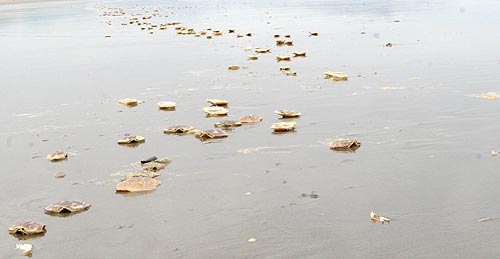 |
Oregon Coast Questions Answered: Why So Many Dead Crab Shells?
Published 11/14/2013

(Oregon Coast) - Finding huge piles of crab shells on the beach? Are you wondering what's killing off all the crabs all of a sudden? (Crab molt photo above courtesy Seaside Aquarium).
It's actually one of the more frequently asked questions to Oregon coast experts.
 If you're walking along the Oregon coast in the late summer or in the spring your chances of spotting this spectacle are pretty good. But they're not a mass die-off of dead crabs at all. It's just that crab tend to molt all at the same time.
If you're walking along the Oregon coast in the late summer or in the spring your chances of spotting this spectacle are pretty good. But they're not a mass die-off of dead crabs at all. It's just that crab tend to molt all at the same time.
The females molt in the spring and the males do this in late summer. This tends to happen all at once, creating masses of crab shells littered on your favorite Oregon coast beach.
Scientists call it crab exuvia.
“It can look like a major disaster occurred to the crab population, but it’s as natural as kids outgrowing their old shoes,” ODFW said.
You can tell the difference between a shell from a molt and a dead crab by looking at the molt line.
Parts of this, by the ODFW's descriptions, sounds like something out of an alien movie. Crabs sometimes molt by losing a lot of their bodies – old gills, antennae and even parts of the mouth. This larger kind of molt is called a whole exuvia.”
“Every detail is there except the crab,” ODFW said. “In summer months, when Dungeness crab molting activity peaks, ODFW usually receives calls reporting 'many dead crab on the beach' which are almost always these molts.”

During their first two years of life, Dungeness crab molt as many as six times year. About three years of age they reach maturity, and then molting happens about once a year.
As the crab begins the molting process, the old exoskeleton starts to to separate from the new one beneath it. The new one starts absorbing water and becomes larger, which causes a kind of split at their molt line. The softer shell beneath gives the crab the flexibility to wiggle out of the old one and it eventually squeezes out backwards.
This softness, however, results in the crab being very vulnerable to predators. It hides in the sand for a while, waiting for the new shell to harden.

Ocean currents wash the crab shells onshore, leaving this wild sight.
By early fall, the crabs have long finished their molting process and begin to fatten up their meat, which is why often December is when crabbing yields the fattest, juiciest catches of crab.
Bay crabbing is best in this time of year, usually through to January or February. Hit the bays at Waldport, Newport, Tillamook and Nehalem (near Manzanita) for some of the best opportunities.
Photos below courtesy Seaside Aquarium. More about the Oregon coast below.


More About Oregon Coast hotels, lodging.....
More About Oregon Coast Restaurants, Dining.....
LATEST Related Oregon Coast Articles
Charleston Crab Feed 2025: 900 Pounds of Dungeness for S. Oregon Coast Visitors |
Secrets of the Season |
Unusual Travel Articles TravelParanormal.com allows you to submit your own creepy tale or debunk one - or see up-to-the-minute news headlines about travel and the paranormal. News Headlines from All Over Oregon Need to scan Oregon headlines? Constantly updated news from all over Oregon: a comprehensive, up-to-the-minute display of news headlines from a variety of media Oregon Coast Oceanfront Lodging, Hotels, Rentals |
Back to Oregon Coast
Contact Advertise on BeachConnection.net
All Content, unless otherwise attributed, copyright BeachConnection.net Unauthorized use or publication is not permitted









































